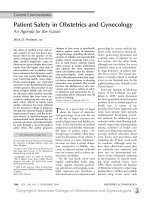Blueprints obstetrics and gynecology 5th edition
Bạn đang xem bản rút gọn của tài liệu. Xem và tải ngay bản đầy đủ của tài liệu tại đây (18.04 MB, 591 trang )
FRONT OF BOOK
↑
[+] Authors
- Preface
- Acknowledgments
[+] Abbreviations
TABLE OF CONTENTS
↑
[+] Part 1 - Obstetrics
[+] Part 2 - Gynecology
BACK OF BOOK
- Questions
- Answers
[+] Index
[+] Color Plates
↑
Preface
In 1997, the first five books in the Blueprints series were published as board review for medical students, interns, and
residents who wanted high-yield, accurate clinical content for USMLE Steps 2 and 3. Twelve years later, we are proud to
report that the original books and the entire Blueprints brand of review materials have far exceeded our expectations.
The feedback we've received from our readers has been tremendously helpful and pivotal in deciding what direction the fifth
edition of the core books would take. To ensure that the fifth edition of the series continues to provide the content and
approach that made the original Blueprints a success; we have expanded the text to include the most up-to-date topics and
evidence-based research and therapies. Information is provided on the latest changes in the management of cervical
dysplasia, preeclampsia, cervical insufficiency, and preterm labor. The newest and future techniques in contraception and
sterilization and hormone replacement therapies are covered, as are contemporary treatment options for uterine fibroids and
invasive breast cancer.
The succinct and telegraphic use of tables and figures was highly acclaimed by our readers, so we have redoubled our efforts
to expand their usefulness by adding a significant amount of updated and improved artwork including a new section of color
plates. In each case, we have tried to include only the most helpful and clear tables and figures to maximize the reader's
ability to understand and remember the material. Our readers also asked for an enhanced art program, so a tri-color system is
being used in this edition to increase the usefulness of the figures and tables.
We have likewise changed our bibliography to include updated evidence-based articles as well as references to classic
articles and textbooks in both obstetrics and gynecology. These references are now provided at the end of the book and are
further expanded in the on-line references. It was also suggested that the review questions should reflect the current format of
the boards. We are particularly proud to include new and revised boardformat questions in this edition with full explanations of
both correct and incorrect options provided in the answers.
What we've also learned from our readers is that Blueprints is more than just board review for USMLE Steps 2 and 3. Students
use the books during their clerkship rotations, subinternships, and as a quick refresher while rotating on various services in
early residency. Residents studying for USMLE Step 3 often use the books for reviewing areas that were not their specialty.
Students in physician assistant, nurse practitioner, and osteopath programs use Blueprints either as a companion or in lieu of
review materials written specifically for their areas.
When we first wrote the book, we had just completed medical school and started residency training. Thus, we hope this new
edition brings both that original viewpoint as well as our clinical experience garnered over the past 12 years. However you
choose to use Blueprints, we hope that you find the books in the series informative and useful.
Tamara L. Callahan MD, MPP
Aaron B. Caughey MD, MPP, MPH, PhD
Abbreviations
Abbreviations
3β-HSD
3β-hydroxysteroid dehydrogenase
5-FU
5-fluorouracil
17α-OHP
17α-hydroxyprogesterone
ABG
arterial blood gas
ACTH
adrenocorticotropic hormone
AD
autosomal dominant
ADH
antidiuretic hormone
AED
antiepileptic drug
AFE
amniotic fluid embolus
AFI
amniotic fluid index
AFLP
acute fatty liver of pregnancy
AFP
α-fetoprotein
AGUS
atypical glandular cells of undetermined significance
AIDS
acquired immunodeficiency syndrome
ALT
alanine transaminase
AMA
advanced maternal age
APA
antiphospholipid antibody
AR
autosomal recessive
ARDS
adult respiratory distress syndrome
AROM
artificial rupture of membranes
ART
assisted reproductive technology
ASC
atypical squamous cells
ASC-H
atypical squamous cells cannot exclude high-grade squamous intraepithelial lesion
ASC-US
atypical squamous cells of undetermined significance
AST
aspartate transaminase
AV
arteriovenous
AZT
zidovudine
β-hCG
beta human chorionic gonadotropin
BID
twice a day
BP
blood pressure
BPP
biophysical profile
BUN
blood urea nitrogen
BV
bacterial vaginosis
CAH
congenital adrenal hyperplasia
CBC
complete blood count
CCCT
clomiphene citrate challenge test
CF
cystic fibrosis
CHF
congestive heart failure
CIN
cervical intraepithelial neoplasia
CKC
cold-knife conization (biopsy)
CMV
cytomegalovirus
CNS
central nervous system
CPD
cephalopelvic disproportion
CPK
creatine phosphokinase
CRS
congenital rubella syndrome
CSF
cerebrospinal fluid
CT
computed tomography (CAT scan)
CVA
cerebrovascular accident
CVAT
costovertebral angle tenderness
CVD
collagen vascular disorders
CVS
chorionic villus sampling
CXR
chest x-ray
DA
developmental age
D&C
dilation and curettage
D&E
dilation and evacuation
DCIS
ductal carcinoma in situ
DES
diethylstilbestrol
DEXA
dual-energy x-ray absorptiometry
DHEA
dehydroepiandrosterone
DHEAS
dehydroepiandrosterone sulfate
DHT
dihydrotestosterone
DIC
disseminated intravascular coagulation
DMPA
depot medroxyprogesterone acetate (Depo-Provera)
DTRs
deep tendon reflexes
DUB
dysfunctional uterine bleeding
DVT
deep venous thrombosis
ECG
electrocardiogram
EDC
estimated date of confinement
EDD
estimated date of delivery
EFW
estimated fetal weight
EIF
echogenic intracardiac focus
ELISA
enzyme-linked immunosorbent assay
EMB
endometrial biopsy
EMG
electromyography
ERT
estrogen replacement therapy
ESR
erythrocyte sedimentation rate
FAS
fetal alcohol syndrome
FH
fetal heart
FHR
fetal heart rate
FIGO
International Federation of Gynecology and Obstetrics
P.xi
FIRS
fetal immune response syndrome
FISH
fluorescent in situ hybridization
FNA
fine-needle aspiration
FSE
fetal scalp electrode
FSH
follicle-stimulating hormone
FTAABS
fluorescent treponemal antibody absorption
FTP
failure to progress
G
gravidity
GA
gestational age
GBS
group B streptococcus
GDM
gestational diabetes mellitus
GFR
glomerular filtration rate
GH
gestational hypertension
GI
gastrointestinal
GIFT
gamete intrafallopian transfer
GLT
glucose loading test
GnRH
gonadotropin-releasing hormone
GSI
genuine stress incontinence
GTD
gestational trophoblastic disease
GTT
glucose tolerance test
GU
genitourinary
HAART
highly active antiretroviral therapy
Hb
hemoglobin
HbH
hemoglobin H disease
hCG
human chorionic gonadotropin
hCS
human chorionic somatomammotropin
Hct
hematocrit
HDL
high-density lipoprotein
HELLP
hemolysis, elevated liver enzymes, low platelets
HIV
human immunodeficiency virus
HLA
human leukocyte antigen
hMG
human menopausal gonadotropin
HPI
history of present illness
HPL
human placental lactogen
HPV
human papillomavirus
HR
heart rate
HRT
hormone replacement therapy
HSG
hysterosalpingogram
HSIL
high-grade squamous intraepithelial lesion
HSV
herpes simplex virus
I&D
incision and drainage
ICSI
intracytoplasmic sperm injection
ID/CC
identification and chief complaint
Ig
immunoglobulin
IM
intramuscular
INH
isoniazid
INR
International Normalized Ratio
ITP
idiopathic thrombocytopenia purpura
IUD
intrauterine device
IUFD
intrauterine fetal demise or death
IUGR
intrauterine growth restricted
IUI
intrauterine insemination
IUP
intrauterine pregnancy
IUPC
intrauterine pressure catheter
IUT
intrauterine transfusion
IVC
inferior vena cava
IVF
in vitro fertilization
IVP
intravenous pyelogram
JVP
jugular venous pressure
KB
Kleihauer-Betke test
KOH
potassium hydroxide
KUB
kidneys/ureter/bladder (x-ray)
LBW
low birth weight
LCHAD
long-chain hydroxyacyl-CoA dehydrogenase
LCIS
lobular carcinoma in situ
LDH
lactate dehydrogenase
LDL
low-density lipoprotein
LEEP
loop electrosurgical excision procedure
LFT
liver function test
LGA
large for gestational age
LGV
lymphogranuloma venereum
LIQ
lower inner quadrant
LH
luteinizing hormone
Lletz
large loop excision of the transformation zone
LMP
last menstrual period
LOQ
lower outer quadrant
LOT
left occiput transverse
LSIL
low-grade squamous intraepithelial lesion
LTL
laparoscopic tubal ligation
Lytes
electrolytes
MAO
monoamine oxidase
MESA
microsurgical epididymal sperm aspiration
MHATP
microhemagglutination assay for antibodies to T. pallidum
MI
myocardial infarction
MIF
müllerian inhibiting factor
MLK
myosin light-chain kinase
MRI
magnetic resonance imaging
MRKH
Mayer-Rokitansky-Kuster-Hauser (syndrome)
MSAFP
maternal serum α-fetoprotein
MTHFR
methyl tetrahydrofolate reductase
NPO
nil per os (nothing by mouth)
NPV
negative predictive value
NRFT
nonreassuring fetal testing
NSAID
nonsteroidal anti-inflammatory drug
NST
nonstress test
NSVD
normal spontaneous vaginal delivery
NT
nuchal translucency
NTD
neural tube defect
OA
occiput anterior
OCP
oral contraceptive pill
P.xii
OCT
oxytocin challenge test
OI
ovulation induction
OP
occiput posterior
OT
occiput transverse
OTC
over-the-counter
P
parity
PBS
peripheral blood smear
PCOD
polycystic ovarian disease
PCOS
polycystic ovarian syndrome
PCR
polymerase chain reaction
PDA
patent ductus arteriosus
PE
physical exam
PE
pulmonary embolus
PET
preeclampsia/toxemia
PFTs
pulmonary function tests
PID
pelvic inflammatory disease
PIH
pregnancy-induced hypertension
PMDD
premenstrual dysphoric disorder
PMN
polymorphonuclear leukocyte
PMOF
premature ovarian failure
PMS
premenstrual syndrome
PO
per os (by mouth)
POCs
products of conception
POP
progesterone-only contraceptive pills
Pop-Q
pelvic organ prolapse quantification system
PPCM
peripartum cardiomyopathy
PPD
purified protein derivative
PPROM
preterm premature rupture of membranes
PPS
postpartum sterilization
PPV
positive predictive value
PROM
premature rupture of membranes
PSTT
placental site trophoblastic tumor
PT
prothrombin time
PTL
preterm labor
PTT
partial thromboplastin time
PTU
propylthiouracil
PUBS
percutaneous umbilical blood sampling
PUS
pelvic ultrasound
QD
each day
QID
four times a day
RBC
red blood cell
RDS
respiratory distress syndrome
ROM
rupture of membranes
ROT
right occiput transverse
RPR
rapid plasma reagin
RR
respiratory rate
SAB
spontaneous abortion
SCC
squamous cell carcinoma
SERM
selective estrogen receptor modulators
SGA
small for gestational age
SHBG
sex hormone binding globulin
SIDS
sudden infant death syndrome
SLE
systemic lupus erythematosus
SNRIs
serotonin-norepinephrine reuptake inhibitor
SPT
septic pelvic thrombophlebitis
SROM
spontaneous rupture of membranes
SSRIs
selective serotonin reuptake inhibitors
STD
sexually transmitted disease
STI
sexually transmitted infection
SUI
stress urinary incontinence
SVT
superficial vein thrombophlebitis
SVT
supraventricular tachycardia
TAB
therapeutic abortion
TAC
transabdominal cerclage
TAHBSO
total abdominal hysterectomy and bilateral salpingo-oophorectomy
TBG
thyroid binding globulin
TENS
transcutaneous electrical nerve stimulation
TFTs
thyroid function tests
TIBC
total iron-binding capacity
TLC
total lung capacity
TNM
tumor/node/metastasis
TOA
tubo-ovarian abscess
TOLAC
trial of labor after cesarean
TOV
transposition of the vessels
tPA
tissue plasminogen activator
TPAL
term, preterm, aborted, living
TRH
thyrotropin-releasing hormone
TSE
testicular sperm extraction
TSH
thyroid-stimulating hormone
TSI
thyroid-stimulating immunoglobulins
TSS
toxic shock syndrome
TSST
toxic shock syndrome toxin
TTTS
twin-to-twin transfusion syndrome
UA
urinalysis
UAE
uterine artery embolization
UG
urogenital
UIQ
upper inner quadrant
UOQ
upper outer quadrant
UPI
uteroplacental insufficiency
US
ultrasound
UTI
urinary tract infection
V/Q
ventilation/perfusion ratio
VAIN
vaginal intraepithelial neoplasia
VBAC
vaginal birth after cesarean
VD
volume of distribution
VDRL
Venereal Disease Research Laboratory
VIN
vulvar intraepithelial neoplasia
VLDL
very low density lipoprotein
VS
vital signs
VSD
ventricular septal defect
VZIG
varicella zoster immune globulin
VZV
varicella zoster virus
WBC
white blood cell
XAFP
expanded maternal serum alpha feto-protein (test)
XR
x-ray
Chapter 1
Pregnancy and Prenatal Care
PREGNANCY
Pregnancy is the state of having products of conception implanted normally or abnormally in the uterus or occasionally
elsewhere. Pregnancy is terminated by spontaneous or elective abortion or delivery. A myriad of physiologic changes occur in
a pregnant woman, which affect every organ system.
DIAGNOSIS
In a patient who has regular menstrual cycles and is sexually active, a period delayed by more than a few days to a week is
suggestive of pregnancy. Even at this early stage, patients may exhibit signs and symptoms of pregnancy. On physical
examination, a variety of findings indicate pregnancy (Table 1-1).
Many over-the-counter (OTC) urine pregnancy tests have a high sensitivity and will be positive around the time of the missed
menstrual cycle. These urine tests and the hospital laboratory serum assays test for the beta subunit of human chorionic
gonadotropin (β-hCG). This hormone produced by the placenta will rise to a peak of 100,000 mIU/mL by 10 weeks of
gestation, decrease throughout the second trimester, and then level off at approximately 20,000 to 30,000 mIU/mL in the third
trimester.
A viable pregnancy can be confirmed by ultrasound, which may show the gestational sac as early as 5 weeks on a
transvaginal ultrasound, or at a β-hCG of 1,500 to 2,000 mIU/mL, and the fetal heart as soon as 6 weeks, or a β-hCG of 5,000
to 6,000 mIU/mL.
TERMS AND DEFINITIONS
From the time of fertilization until the pregnancy is 8 weeks along (10 weeks gestational age [GA]), the conceptus is called an
embryo. After 8 weeks until the time of birth, it is designated a fetus. The term infant is used for the period between delivery
and 1 year of age. Pregnancy is divided into trimesters. The first trimester lasts until 12 weeks but is also defined as up to 14
weeks GA, the second trimester from 12 to 14 until 24 to 28 weeks GA, and the third trimester from 24 to 28 weeks until
delivery. An infant delivered prior to 24 weeks is considered to be previable, from 24 to 37 weeks is considered preterm, and
from 37 to 42 weeks is considered term. A pregnancy carried beyond 42 weeks is considered postterm.
Gravidity (G) refers to the number of times a woman has been pregnant, and parity (P) refers to the number of pregnancies
that led to a birth at or beyond 20 weeks GA or of an infant weighing more than 500 g. For example, a woman who has given
birth to one set of twins would be a G1 P1, as a multiple gestation is considered as just one pregnancy. A more specific
designation of pregnancy outcomes divides parity into term and preterm deliveries and also adds the number of abortuses
and number of living children. This is known as the TPAL designation. Abortuses include all pregnancy losses prior to 20
weeks, both therapeutic and spontaneous, as well as ectopic pregnancies. For example, a woman who has given birth to one
set of preterm twins, one term infant, and with two miscarriages would be a G4 P1-1-2-3.
P.4
TABLE 1-1 Signs and Symptoms of Pregnancy
Signs
Bluish discoloration of vagina and cervix (Chadwick sign)
Softening and cyanosis of the cervix at or after 4 weeks (Goodell sign)
Softening of the uterus after 6 weeks (Ladin sign)
Breast swelling and tenderness
Development of the linea nigra from umbilicus to pubis
Telangiectasias
Palmar erythema
Symptoms
Amenorrhea
Nausea and vomiting
Breast pain
Quickening—fetal movement
The prefixes nulli-, primi-, and multi- are used with respect to gravidity and parity to refer to having 0, 1, or more than 1,
respectively. For example, a woman who has been pregnant twice, one ectopic pregnancy and one full term birth, would be
multigravidous and primiparous. Unfortunately, this terminology often gets misused with individuals referring to women with a
first pregnancy as primiparous, rather than nulliparous. Obstetricians also utilize the term “grand multip,” which refers to a
woman whose parity is greater than or equal to 5.
DATING OF PREGNANCY
The GA of a fetus is the age in weeks and days measured from the last menstrual period (LMP). Developmental age (DA) or
conceptional age or embryonic age is the number of weeks and days since fertilization. Because fertilization usually occurs
about 14 days after the first day of the prior menstrual period, the GA is usually 2 weeks more than the DA.
Classically, Nägele's rule for calculating the estimated date of confinement (EDC), or estimated date of delivery (EDD), is
to subtract 3 months from the LMP and add 7 days. Thus, a pregnancy with an LMP of 8/05/08 would have an EDC of
5/12/09. Exact dating uses an EDC calculated as 280 days after a certain LMP. If the date of ovulation is known, as in
assisted reproductive technology (ART), the EDC can be calculated by adding 266 days. Pregnancy dating can be confirmed
and should be consistent with the examination of the uterine size at the first prenatal appointment.
With an uncertain LMP, ultrasound is often used to determine the EDC. Ultrasound has a level of uncertainty that increases
during the pregnancy but it is rarely off by more than 7% to 8% at any GA. A safe rule of thumb is that the ultrasound should
not differ from LMP dating by more than 1 week in the first trimester, 2 weeks in the second trimester, and 3 weeks in the third
trimester. The dating done with crown-rump length in the first half of the first trimester is probably even more accurate, to
within 3 to 5 days.
Other measures used to estimate gestational age include pregnancy landmarks such as auscultation of the fetal heart (FH) at
20 weeks by nonelectronic fetoscopy or at 10 weeks by Doppler ultrasound, as well as maternal awareness of fetal movement
or “quickening,” which occurs between 16 and 20 weeks.
Because ultrasound dating of pregnancy only decreases in accuracy as the pregnancy progresses, determining and confirming
pregnancy dating at the first interaction between a pregnant women and the healthcare system is imperative. A woman who
presents to the emergency department may not return for prenatal care, so dating confirmation should occur at that visit.
Pregnancy dating is particularly important because a number of decisions regarding care are based on accurate dating. One
such decision is whether to resuscitate a newborn at the threshold of viability, which may be at 23 or 24 weeks of gestation
depending on the institution. Another is the induction of labor at 41 weeks of gestation. Since 5% to 15% of women may be
oligo-ovulatory, they ovulate beyond the usual 14th day of the cycle. Thus, their LMP dating may overdiagnose a prolonged
(≥41 weeks' gestation) or postterm pregnancy (≥42 weeks' gestation). Thus, early verification or correction of dating can
correct such misdating.
PHYSIOLOGY OF PREGNANCY
Cardiovascular
During pregnancy, cardiac output increases by 30% to 50%. Most increases occur during the first trimester,
P.5
with the maximum being reached between 20 and 24 weeks' gestation and maintained until delivery. The increase in cardiac
output is first due to an increase in stroke volume then is maintained by an increase in heart rate as stroke volume decreases
to near prepregnancy levels by the end of the third trimester. Systemic vascular resistance decreases during pregnancy,
resulting in a fall in arterial blood pressure. This decrease is most likely due to the elevated progesterone leading to smooth
muscle relaxation. There is a decrease in systolic blood pressure of 5 to 10 mm Hg and in diastolic blood pressure of 10 to 15
mm Hg that nadirs at week 24. Between 24 weeks' gestation and term, blood pressure slowly returns to prepregnancy levels
but should never exceed them.
Pulmonary
There is an increase of 30% to 40% in tidal volume (VT) during pregnancy (Fig. 1-1) despite the fact that the total lung
capacity is decreased by 5% due to the elevation of the diaphragm. This increase in V T decreases the expiratory reserve
volume by about 20%. The increase in VT with a constant respiratory rate leads to an increase in minute ventilation of 30% to
40%, which in turn leads to an increase in alveolar (PAo2 ) and arterial (Pao 2 ) Po2 levels and a decrease in PAco2 and Paco 2
levels.
Paco 2 decreases to approximately 30 mm Hg by 20 weeks' gestation from 40 mm Hg prepregnancy. This change leads to an
increased CO2 gradient between mother and fetus and is likely caused by elevated progesterone levels that either increase
the respiratory system's responsiveness to CO2 or act as a primary stimulant. This gradient facilitates oxygen delivery to the
fetus and carbon dioxide removal from the fetus. Dyspnea of pregnancy occurs in 60% to 70% of patients. This is possibly
secondary to decreased Paco 2 levels, increased V T , or decreased total lung capacity (TLC).
Figure 1-1 • Lung volumes in nonpregnant and pregnant women.
Gastrointestinal
Nausea and vomiting occur in more than 70% of pregnancies. This has been termed “morning sickness” even though it can
occur anytime throughout the day. These symptoms have been attributed to the elevation in estrogen, progesterone, and
hCG. It may also be due to hypoglycemia and can be treated with frequent snacking. The nausea and vomiting typically
resolve by 14 to 16 weeks' gestation. Hyperemesis gravidarum refers to a severe form of morning sickness in which women
lose greater than 5% of their prepregnancy weight and go into ketosis.
During pregnancy, the stomach has prolonged gastric emptying times, and the gastroesophageal sphincter has decreased
tone. Together, these changes lead to reflux and possibly combine with decreased esophageal tone to cause ptyalism, or
spitting, during pregnancy. The large bowel also has decreased motility, which leads to increased water absorption and
constipation.
Renal
The kidneys increase in size and the ureters dilate during pregnancy, which may lead to increased rates of pyelonephritis. The
glomerular filtration rate (GFR) increases by 50% early in pregnancy and is maintained until delivery. As a result of increased
P.6
GFR, blood urea nitrogen and creatinine decrease by about 25%. An increase in the renin-angiotensin system leads to
increased levels of aldosterone, which results in increased sodium resorption. However, plasma levels of sodium do not
increase because of the simultaneous increase in GFR.
Hematology
Although the plasma volume increases by 50% in pregnancy, the red blood cell volume increases by only 20% to 30%, which
leads to a decrease in the hematocrit, or dilutional anemia. The white blood cell (WBC) count increases during pregnancy to a
mean of 10.5 million/mL with a range of 6 to 16 million. During labor, stress may cause the WBC count to rise to over 20
million/mL. There is a slight decrease in the concentration of platelets, probably secondary to increased plasma volume and
an increase in peripheral destruction. Although 7% to 8% of patients' platelets may be between 100 and 150 million/mL, a
drop in the platelet count below 100 million/mL or over a short time period is not normal and should be investigated promptly.
Pregnancy is considered to be a hypercoagulable state, and the number of thromboembolic events increases. There are
elevations in the levels of fibrinogen and factors VII-X. However, the actual clotting and bleeding times do not change. The
increased rate of thromboembolic events in pregnancy may also be secondary to the other elements of Virchow triad, an
increase in venous stasis and vessel endothelial damage.
Endocrine
Pregnancy is a hyperestrogenic state. The increased estrogen is produced primarily by the placenta, with the ovaries
contributing to a lesser degree. Unlike estrogen production in the ovaries, where estrogen precursors are produced in ovarian
theca cells and transferred to the ovarian granulosa cells, estrogen in the placenta is derived from circulating plasma-borne
precursors produced by the maternal adrenal glands. Fetal well-being has been correlated with maternal serum estrogen levels
with low estrogen levels being associated with conditions such as fetal death and anencephaly.
The hormone hCG is composed of two dissimilar alpha and beta subunits. The alpha subunit of hCG is identical to the alpha
subunits of luteinizing hormone (LH), follicle-stimulating hormone (FSH), and thyroid-stimulating hormone (TSH), whereas the
beta subunits differ. Levels of hCG double approximately every 48 hours during early pregnancy, reaching a peak at
approximately 10 to 12 weeks, and thereafter declining to reach a steady state after week 15.
The placenta produces hCG, which acts to maintain the corpus luteum in early pregnancy. The corpus luteum produces
progesterone, which maintains the endometrium. Eventually the placenta takes over progesterone production and the corpus
luteum degrades into the corpus albicans. Progesterone levels increase over the course of pregnancy. Progesterone causes
relaxation of smooth muscle, which has multiple effects on the gastrointestinal, cardiovascular, and genitourinary systems.
Human placental lactogen (hPL) is produced in the placenta and is important for ensuring a constant nutrient supply to the
fetus. hPL, also known as human chorionic somatomammotropin (hCS), causes lipolysis with a concomitant increase in
circulating free fatty acids. hPL also acts as an insulin antagonist, along with various other placental hormones, thereby having
a diabetogenic effect. This leads to increased levels of insulin and protein synthesis. Levels of prolactin are markedly
increased during pregnancy. These levels decrease after delivery but later increase in response to suckling.
There are two major changes in thyroid hormones during pregnancy. First, estrogen stimulates thyroid binding globulin (TBG)
leading to an elevation in total T3 and T4 but free T3 and T4 remain relatively constant. Second, hCG has a weak stimulating
effect on the thyroid, likely as its alpha subgroup is similar to TSH. This leads to a slight increase in T3 and T4 and a slight
decrease in TSH early in pregnancy. Overall, however, pregnancy is considered a euthyroid state.
Musculoskeletal and Dermatologic
The obvious change in the center of gravity during pregnancy can lead to a shift in posture and lower back strain. Numerous
changes in the skin occur during pregnancy, including spider angiomata and palmar erythema secondary to increased
estrogen levels and hyperpigmentation of the nipples, umbilicus, abdominal midline (the linea nigra), perineum, and face
(melasma or chloasma) secondary to increased levels of melanocyte-stimulating hormone and the steroid hormones.
P.7
Nutrition
Nutritional requirements increase during pregnancy and breastfeeding. The average woman requires 2,000 to 2,500 kcal/day.
The caloric requirement is increased by 300 kcal/day during pregnancy and by 500 kcal/day when breastfeeding. Most
patients should gain between 20 and 30 pounds during pregnancy. Overweight women are advised to gain less, between 15
and 25 pounds; underweight women are advised to gain more, 28 to 40 pounds.
In addition to the increased caloric requirements, there are increased nutritional requirements for protein, iron, folate, calcium,
and other vitamins and minerals. The protein requirement increases from 60 g/day to 70 or 75 g/day. Recommended calcium
intake is 1.5 g/day. Many patients develop iron deficiency anemia because of the increased demand on hematopoiesis both by
the mother and the fetus. Folate requirements increase from 0.4 to 0.8 mg/day and are important in preventing neural tube
defects.
TABLE 1-2 Recommended Daily Dietary Allowances for Nonpregnant, Pregnant, and
Lactating Women
Nonpregnant Women by Age
Pregnant Lactating
11 to 14 15 to 18 19 to 22 23 to 50
Energy
(kcal)
51+
Women Women
2,400
2,100
2,100
2,000
1,800
+300
+500
Protein (g)
44
48
46
46
46
+30
+20
Fat-soluble
vitamins
800
800
800
800
800
1,000
1,200
Vitamin A
activity (RE)
(IU)
4,000
4,000
4,000
4,000
4,000
5,000
6,000
400
400
400
—
—
400
400
12
12
12
12
12
15
15
45
45
45
45
45
60
80
Folacin (µg)
400
400
400
400
400
800
600
Niacin (mg)
16
14
14
13
12
+2
+4
Riboflavin
(mg)
1.3
1.4
1.4
1.2
1.1
+0.3
+0.5
Thiamin (mg)
1.2
1.1
1.1
1
1
+0.3
+0.3
Vitamin B 6
(mg)
1.6
2
2
2
2
2.5
2.5
3
3
3
3
3
4
4
Vitamin D
(IU)
Vitamin E
activity (IU)
Watersoluble
vitamins
Ascorbic acid
(mg)
Vitamin B12
(µg)
Minerals
Calcium (mg)
1,200
1,200
800
800
800
1,200
1,200
115
115
100
100
80
125
150
18
18
18
18
10
+18
18
Magnesium
(mg)
300
300
300
300
300
450
450
Phosphorus
(mg)
1,200
1,200
800
800
800
1,200
1,200
15
15
15
15
15
20
25
Iodine (µg)
Iron (mg)
Zinc (mg)
From Gabbe SG, Niebyl JR, Simpsen JL. Obstetrics: Normal and Problem
Pregnancies, 4th ed. New York: Churchill Livingstone, 2002:196. IU, International
Unit.
All patients are advised to take prenatal vitamins during pregnancy. These are designed to compensate for the increased
nutritional demands of pregnancy. Furthermore, any patient whose hematocrit falls during pregnancy is advised to increase
iron intake with oral supplementation (Table 1-2).
P.8
PRENATAL CARE
Prenatal visits are designed to screen for various complications of pregnancy and to educate the patient. They include a series
of outpatient office visits that involve routine physical examinations and various screening tests that occur at different points in
the prenatal care. Important issues of prenatal care include initial patient evaluation, routine patient evaluation, nutrition,
disease states during the pregnancy, and preparing for the delivery.
INITIAL VISIT
This is often the longest of the prenatal visits because it involves obtaining a complete history and performing a physical as well
as a battery of initial laboratory tests. It should occur early in the first trimester, between 6 and 10 weeks, although
occasionally patients will not present for their initial prenatal visit until later in their pregnancy.
History
The patient's history includes the present pregnancy, the last menstrual period, and symptoms during the pregnancy. After this,
an obstetric history of prior pregnancies including date, outcome (e.g., SAB [spontaneous abortion], TAB [therapeutic
abortion], ectopic pregnancy, term delivery), mode of delivery, length of time in labor and second stage, birth weight, and any
complications. Finally, a complete medical, surgical, family, and social history should be obtained.
Physical Examination
A complete physical examination is performed, paying particular attention to the patient's prior medical and surgical history.
The pelvic examination includes a Pap smear, unless one has been done in the past 6 months, and cultures for gonorrhea and
chlamydia. On bimanual examination, the size of the uterus should be consistent with the gestational age from the LMP. If a
woman is unsure of her LMP or size and dates are not consistent, one should obtain an ultrasound for dating. Accurate dating
is crucial for all subsequent obstetrical evaluations and interventions.
Diagnostic Evaluation
The panel of tests in the first trimester includes a complete blood count, primarily for hematocrit, blood type, antibody screen,
rapid plasma reagin (RPR) or VDRL screening for syphilis, rubella antibody screen, hepatitis B surface antigen, urinalysis, and
urine culture. If a patient has no history of chickenpox, a titer for varicella zoster virus (VZV) antibodies is sent. A purified
protein derivative (PPD) is usually placed during the first or second trimester. A urine pregnancy test should be sent if the
patient is not entirely certain she is pregnant. If there has been any bleeding or cramping, a β-hCG level should be obtained.
While there is some debate over the use of routine toxoplasma titers, they are often ordered as well. All patients are counseled
about human immunodeficiency virus (HIV) and testing should be offered routinely (Table 1-3). In addition, first trimester
screening tests for aneuploidy with nuchal translucency (NT) by ultrasound and serum markers are increasingly being
obtained in most women via referral to a prenatal diagnosis unit. In addition to this battery of tests, there are a variety of other
screens offered to high-risk patients (Table 1-4).
ROUTINE PRENATAL VISITS
Blood pressure, weight, urine dipstick, measurement of the uterus, and auscultation of the fetal heart are performed and
assessed on each follow-up prenatal care visit. Maternal blood pressure decreases during the first and second trimester and
slowly returns to baseline during the third trimester; elevation may be a sign of preeclampsia. Maternal weight is followed
serially throughout the pregnancy as a proxy for adequate nutrition. Also, large weight gains toward the end of pregnancy can
be a sign of fluid retention and preeclampsia. Measurement of the uterine fundal height in centimeters corresponds roughly to
the weeks of gestation. If the fundal height is progressively decreasing or is 3 cm less than gestational age, an ultrasound is
done to more accurately assess fetal growth. After 10 to 14 weeks, Doppler ultrasound is used to auscultate the fetal heart
rate. Urine is routinely dipped for protein, glucose, blood, and leukocyte esterase. Protein may be indicative of preeclampsia,
glucose of diabetes, and leukocyte esterase of urinary tract infection (UTI). Pregnant women are at an increased risk for
complicated UTIs such as pyelonephritis given increased urinary stasis
P.9
from mechanical compression of the ureters and progesterone-mediated smooth muscle relaxation.
TABLE 1-3 Routine Tests in Prenatal Care
Initial Visit and First Trimester
Second Trimester
Third
Trimester
Hematocrit
MSAFP/triple or quad
screen
Hematocrit
Blood type and screen
Obstetric ultrasound
RPR/VDRL
RPR/VDRL
Amniocentesis for women
interested in prenatal
diagnosis
GLT
Rubella antibody screen
Group B
strep
culture
Hepatitis B surface antigen
Gonorrhea culture
Chlamydia culture
PPD
Pap smear
Urinalysis and culture
VZV titer in patients with no history
of exposure
HIV offered
Early screening for aneuploidy
(nuchal translucency plus serum
markers)
TABLE 1-4 Initial Screens in Specific High-Risk Groups
High-Risk Group
Specific Test
African American, Southeast Asian, MCV
<70
Sickle-cell prep for African
Americans; Hgb electrophoresis
Family history of genetic disorder (e.g.,
hemophilia, sickle-cell disease, fragile X
syndrome), maternal age 35 or older at time
of EDC
Prenatal genetics referral
Prior gestational diabetes, family history of
diabetes, Hispanic, Native American,
Southeast Asian
Early glucose loading test
Pregestational diabetes, unsure dates,
recurrent miscarriages
Dating sonogram at first visit









